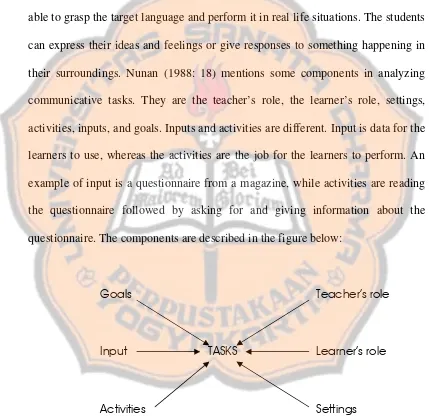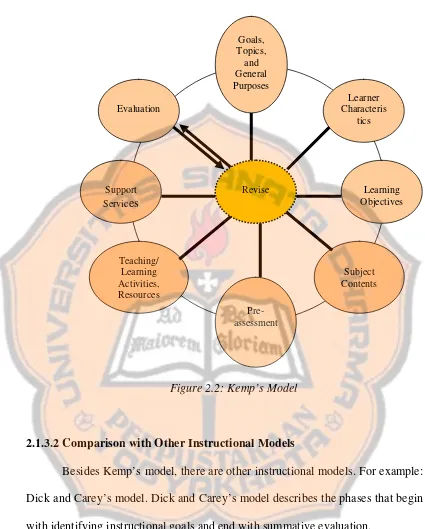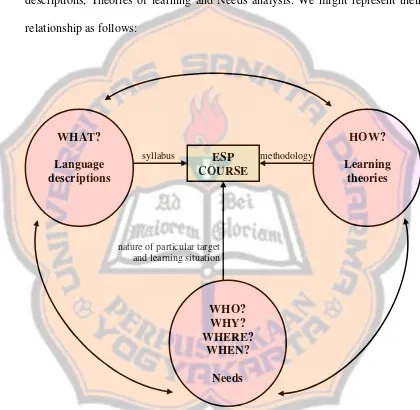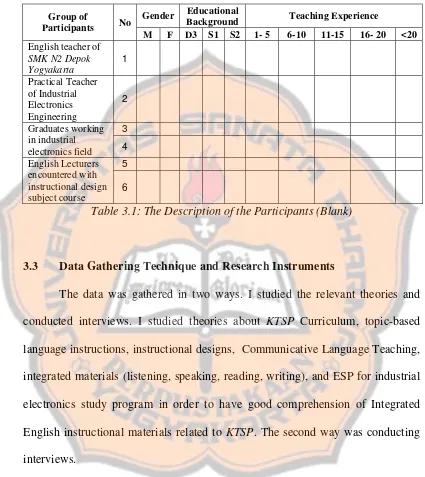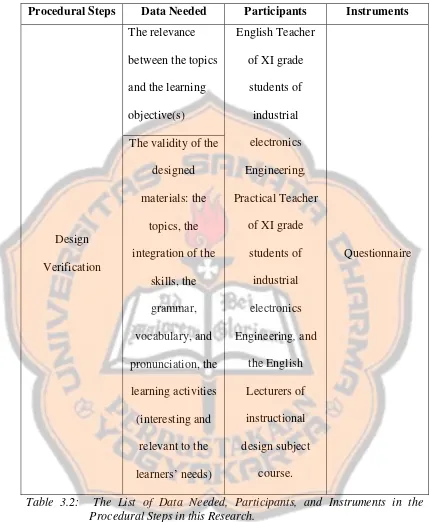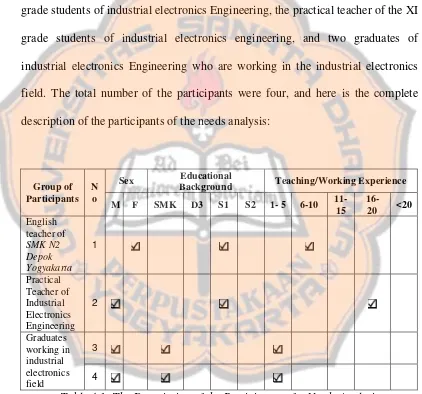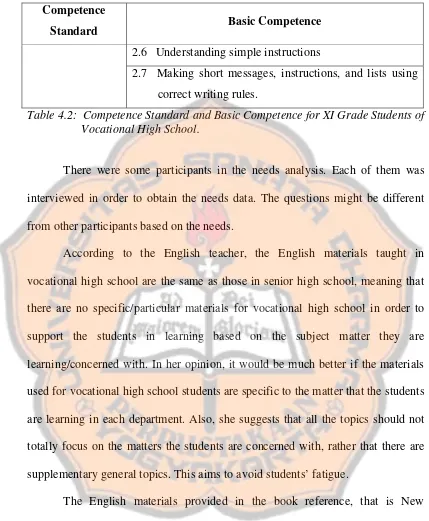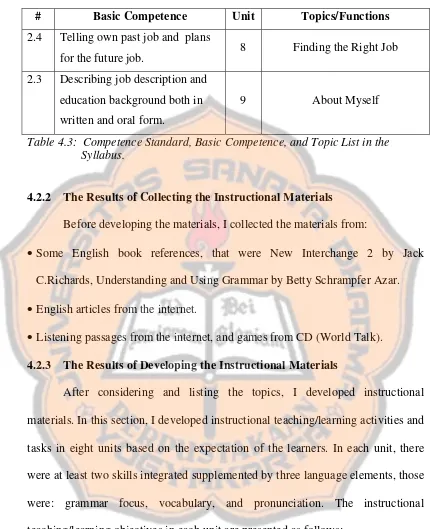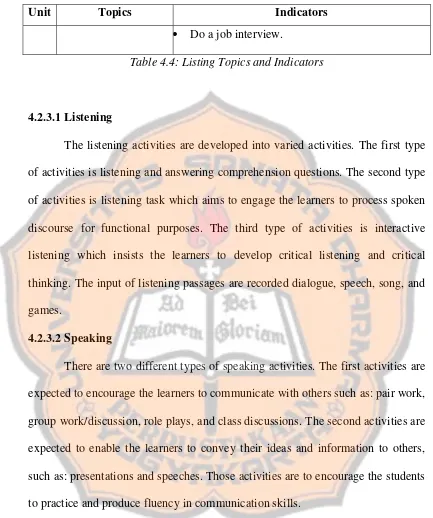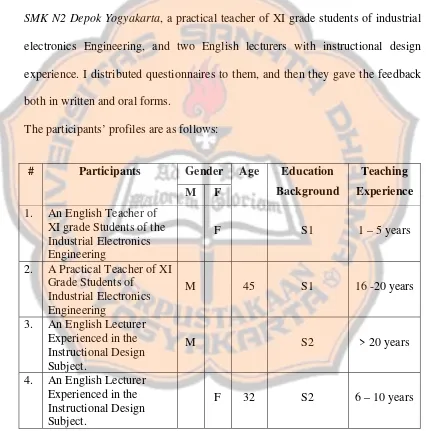vii
ABSTRACT
Delima, Pebny. (2010). Integrated English Instructional Materials for XI Grade Students of Industrial Electronics Engineering. Yogyakarta: English Language Education Study Program, Sanata Dharma University.
The purpose of this study is to develop Integrated English Instructional Materials for XI Grade Students of Industrial Electronics Engineering. This design intends to develop students’ proficiency of language skills, those are: listening, speaking, reading, and writing. The design also proposes to develop the students’ critical thinking to help them solve social problems throughout the course by developing their proficiency in language skills in real contexts.This study is concerned with a problem, that is: “What is the proposed design of Integrated English Instructional Materials for XI Grade Students of Industrial Electronics Engineering.
I applied Kemp’s Instructional Design Model and Borg and Gall’s R&D system to design the material. That was Integrated English Instructional Materials for XI Grade Students of Industrial Electronics Engineering. There were four procedural steps, these are: 1) Conducting a Needs Analysis, 2) Designing the syllabus and developing the materials, 3) Conducting Preliminary Testing, and 4) Revising the design. I also applied the theories and principles of Communicative Language Teaching, Content-Based Language Instruction, and Integrated Language Instruction in developing instructional materials in order to improve the students’ integrated communicative skills. The purpose of conducting preliminary testing was to obtain input, feedback, comments, and suggestions from the participants in the evaluation process, they were: an English teacher of XI grade students of industrial electronics engineering of SMK N2 Depok Yogyakarta, a practical teacher of XI grade students of industrial electronics engineering of SMK N2 Depok Yogyakarta, two graduate students of industrial electronics engineering of SMK N2 Depok Yogyakarta who work in the industrial electronics field, and two experts (lecturers) who teach the Instructional Design subject. The result of the evaluation analysis showed that the the designed materials are relevant and suitable for XI grade students of industrial electronics engineering for they meet their needs, which are industrial electronics matters in particular and professionalism in work in general. All the input, feedback, comments, and suggestions were applied in order to improve the designed materials.
viii ABSTRAK
Delima, Pebny. (2010). Integrated English Instructional Materials for XI Grade Students of Industrial Electronics Engineering. Yogyakarta: Pendidikan Bahasa Inggris, Universitas Sanata Dharma.
Studi ini bertujuan untuk mengembangkan materi pembelajaran bahasa inggris untuk siswa SMK kelas XI jurusan elektronika industri. Desain ini bertujuan untuk mengembangkan kelancaran keterampilan/keahlian siswa dalam bahasa Inggris, yaitu: mendengarkan, berbicara, membaca, dan menulis. Desain ini juga bertujuan untuk mengembangkan cara berpikir kritis siswa melalui pemecahan masalah dalam konteks pembelajaran yang sebenarnya. Studi ini berhubungan dengan sebuah pertanyaan, yaitu: “Seperti apakah rancangan materi pembelajaran bahasa inggris terpadu dan instruksional berdasarkan topik untuk siswa kelas XI jurusan elektronika industri?”.
Saya menerapkan model Kemp’s Instructional Design dan Borg and Gall’s R&D untuk menjawab pertanyaan di atas. Kemudian, saya menerapkan kedua model tersebut untuk mengembangkan materi pembelajaran bahasa inggris terpadu dan instruksional berdasarkan topik untuk siswa kelas XI jurusan elektronika industri. Terdapat empat langkah, yaitu: 1) melakukan survey kebutuhan, 2) mendesain silabus dan mengembakngkan materi, 3) melakukan evaluasi desain, dan 4) melakukan revisi desain. Saya juga menerapkan metode-metode dan prinsip-prinsip Communicative Language Teaching, Content-Based Language Instruction, dan Integrated Language dalam mengembangkan materi instruksional ini dengan upaya untuk meningkatkan keterampilan siswa dalam berkomunikasi menggunakan bahasa inggris. Adapun tujuan dari dilaksanakannya evaluasi desain adalah untuk lebih meningkatkan lagi rancangan materi yang saya buat. Hal ini bertujuan untuk mendapatkan masukan, timbal balik, komentar, dan pendapat dari peserta evaluasi, yaitu: seorang guru bahasa inggris kelas XI jurusan elektronika industri di SMK N2 Depok Yogyakarta, seorang guru praktek kelas XI jurusan elektronika industri di SMK N2 Depok Yogyakarta, dua orang alumnus jurusan elektronika industri SMK N2 Depok Yogyakarta yang sekarang ini sudah bekerja di bidang elektronika industri, dan dua orang ahli (dosen) mata kuliah Instructional Design. Hasil dari analisa evaluasi menunjukkan bahwa rancangan materi ini cocok dan sesuai untuk siswa kelas XI jurusan elektronika industri karena materi tersebut sudah memenuhi kebutuhan siswa, yaitu berkaitan dengan bidang elektronika industri pada khususnya dan dunia pekerjaan pada umumnya. Keseluruhan dari masukan, timbal balik, komentar, dan pendapat yang didapat kemudian diterapkan untuk meningkatkan kualitas rancangan materi.
INTEGRATED ENGLISH INSTRUCTIONAL MATERIALS FOR XI GRADE STUDENTS OF INDUSTRIAL ELECTRONICS ENGINEERING
A THESIS
Presented as Partial Fulfillment of the Requirements to Obtain the Sarjana Pendidikan Degree
in English Language Education
By Pebny Delima
Student Number : 041214145
ENGLISH LANGUAGE EDUCATION STUDY PROGRAM DEPARTMENT OF LANGUAGE AND ARTS EDUCATION FACULTY OF TEACHERS TRAINING AND EDUCATION
SANATA DHARMA UNIVERSITY YOGYAKARTA
iv
FOLLOW YOUR DREAM
Follow your dream...
Take one step at a time and don’t settle for less Just continue to climb.
Follow your dream...
If you stumble, don’t stop and lose sight of your goal Press to the top.
For only on top can we see the whole view Can we see what we’ve done and what we can do Can we then have the vision to seek something new
Press on. Follow your dream.
-Amanda Bradley- www.pravsworld.com
inspiring you for a better tomorrow
I gratefully dedicate this thesis to my beloved Pa who rests in peace and my beloved Ma. This thesis is one of thousands great creation of your daughter. Thank you for being my parents. You mean love, affection, patience, and lots unspoken words. But you can find them when you look into my eyes, and I feel them when I look back into your eyes.Thank you for everything given to me.
vii
ABSTRACT
Delima, Pebny. (2010). Integrated English Instructional Materials for XI Grade Students of Industrial Electronics Engineering. Yogyakarta: English Language Education Study Program, Sanata Dharma University.
The purpose of this study is to develop Integrated English Instructional Materials for XI Grade Students of Industrial Electronics Engineering. This design intends to develop students’ proficiency of language skills, those are: listening, speaking, reading, and writing. The design also proposes to develop the students’ critical thinking to help them solve social problems throughout the course by developing their proficiency in language skills in real contexts.This study is concerned with a problem, that is: “What is the proposed design of Integrated English Instructional Materials for XI Grade Students of Industrial Electronics Engineering.
I applied Kemp’s Instructional Design Model and Borg and Gall’s R&D system to design the material. That was Integrated English Instructional Materials for XI Grade Students of Industrial Electronics Engineering. There were four procedural steps, these are: 1) Conducting a Needs Analysis, 2) Designing the syllabus and developing the materials, 3) Conducting Preliminary Testing, and 4) Revising the design. I also applied the theories and principles of Communicative Language Teaching, Content-Based Language Instruction, and Integrated Language Instruction in developing instructional materials in order to improve the students’ integrated communicative skills. The purpose of conducting preliminary testing was to obtain input, feedback, comments, and suggestions from the participants in the evaluation process, they were: an English teacher of XI grade students of industrial electronics engineering of SMK N2 Depok Yogyakarta, a practical teacher of XI grade students of industrial electronics engineering of SMK N2 Depok Yogyakarta, two graduate students of industrial electronics engineering of SMK N2 Depok Yogyakarta who work in the industrial electronics field, and two experts (lecturers) who teach the Instructional Design subject. The result of the evaluation analysis showed that the the designed materials are relevant and suitable for XI grade students of industrial electronics engineering for they meet their needs, which are industrial electronics matters in particular and professionalism in work in general. All the input, feedback, comments, and suggestions were applied in order to improve the designed materials.
viii ABSTRAK
Delima, Pebny. (2010). Integrated English Instructional Materials for XI Grade Students of Industrial Electronics Engineering. Yogyakarta: Pendidikan Bahasa Inggris, Universitas Sanata Dharma.
Studi ini bertujuan untuk mengembangkan materi pembelajaran bahasa inggris untuk siswa SMK kelas XI jurusan elektronika industri. Desain ini bertujuan untuk mengembangkan kelancaran keterampilan/keahlian siswa dalam bahasa Inggris, yaitu: mendengarkan, berbicara, membaca, dan menulis. Desain ini juga bertujuan untuk mengembangkan cara berpikir kritis siswa melalui pemecahan masalah dalam konteks pembelajaran yang sebenarnya. Studi ini berhubungan dengan sebuah pertanyaan, yaitu: “Seperti apakah rancangan materi pembelajaran bahasa inggris terpadu dan instruksional berdasarkan topik untuk siswa kelas XI jurusan elektronika industri?”.
Saya menerapkan model Kemp’s Instructional Design dan Borg and Gall’s R&D untuk menjawab pertanyaan di atas. Kemudian, saya menerapkan kedua model tersebut untuk mengembangkan materi pembelajaran bahasa inggris terpadu dan instruksional berdasarkan topik untuk siswa kelas XI jurusan elektronika industri. Terdapat empat langkah, yaitu: 1) melakukan survey kebutuhan, 2) mendesain silabus dan mengembakngkan materi, 3) melakukan evaluasi desain, dan 4) melakukan revisi desain. Saya juga menerapkan metode-metode dan prinsip-prinsip Communicative Language Teaching, Content-Based Language Instruction, dan Integrated Language dalam mengembangkan materi instruksional ini dengan upaya untuk meningkatkan keterampilan siswa dalam berkomunikasi menggunakan bahasa inggris. Adapun tujuan dari dilaksanakannya evaluasi desain adalah untuk lebih meningkatkan lagi rancangan materi yang saya buat. Hal ini bertujuan untuk mendapatkan masukan, timbal balik, komentar, dan pendapat dari peserta evaluasi, yaitu: seorang guru bahasa inggris kelas XI jurusan elektronika industri di SMK N2 Depok Yogyakarta, seorang guru praktek kelas XI jurusan elektronika industri di SMK N2 Depok Yogyakarta, dua orang alumnus jurusan elektronika industri SMK N2 Depok Yogyakarta yang sekarang ini sudah bekerja di bidang elektronika industri, dan dua orang ahli (dosen) mata kuliah Instructional Design. Hasil dari analisa evaluasi menunjukkan bahwa rancangan materi ini cocok dan sesuai untuk siswa kelas XI jurusan elektronika industri karena materi tersebut sudah memenuhi kebutuhan siswa, yaitu berkaitan dengan bidang elektronika industri pada khususnya dan dunia pekerjaan pada umumnya. Keseluruhan dari masukan, timbal balik, komentar, dan pendapat yang didapat kemudian diterapkan untuk meningkatkan kualitas rancangan materi.
ix
ACKNOWLEDGEMENTS
There were many people who had contributed to the completion of this undergraduated thesis. They had contributed all the best for me so that finally I was able to acomplish and proudly present this undergraduate thesis “Integrated English Instructional Materials for XI Grade Students of Industrial Electronics Engihneering’.
First of all, I would like to express my great thanks to Jesus Christ, The Almighty God for His blessings in every step I had passed, for His guide in every mountain I had climbed, and for His help in every sea I had crossed.
My deep gratitude goes to my parents who had supported and provided funds for me, but their affection, patient and prayer are beyond everything. I would like to thank all my family for showing me their love and best support. I know they were there for me and will always be.
My sincere gratitude goes to Sanata Dharma University for giving me a wonderful space to study and to express my talents, and for guiding me to be a better person. I would like to thank my major thesis sponsor, Gregorius Punto Aji, S.Pd., M.Hum. for his guidance, precious time, and criticism for my thesis. It was obvious that without his help, this thesis would not be a complete one. I gratefully thank Sr. Clare Hand, fcJ. for helping me with my grammar, Drs. Y. B. Gunawan, M.A. and Christina Kristiyani, S.Pd., M.Pd. for giving input, feedback, comments,and suggestions toward the design, my academic advisor
Drs. A. Herujiyanto, M.A., Ph.D. for his guidance through the whole semesters I had passed well. I also would like to thank all lecturers of English Education Study Program for giving me great amount of knowledge and education values. I thank all staff of English Education Study Program and Foundation of Sanata Dharma University for their help and hospitality.
x
students of industrial electronics engineering) for her guidance, precious time, and criticism for my thesis so that eventually I could finish it well. I also would like thank Bp. Suroto (practical teacher of XI grade students of industrial electronics engineering) for your input, feedback, comments, and suggestions toward the design so that eventually I could make it into a better one.
My special thank goes to my best friends: Claret Etsa Artriani, Sebastian Brotoseno, Valentina, Ardita Yulia Safitri, Esti Supadmi, Linda Gusviariani, Mayora Pirena Toto, and Debora Ayu Hendrawardani for supporting me and providing space to love and share each other. I would also like to thank my great companions in Sanata Dharma University: Matius Hebi Anjarmoko, Oki Putra Darmawan, Alexy Ramano, and Ika Wahyu Wulandari. I had the best times with them.
I also thank all students of Education Study Program, especially my classmates and those of 2004. Thanks for joining me in the academic battle. I’ve learned a lot from them all.
Finally, I would like to say that it was a very very marvelous time to have them all in my life.
xi
TABLE OF CONTENTS
Page
TITLE PAGE ... i
APPROVAL PAGES ... ii
DEDICATION ... iv
STATEMENT OF WORK’S ORIGINALITY ... v
ABSTRACT ……….... vii
ABSTRAK ………... viii
ACKNOWLEDGEMENTS ……… ix
TABLE OF CONTENTS ………. xi
LIST OF TABLES ………... xiii
LIST OF FIGURES ………. xiv
LIST OF APPENDICES ……….. xv
CHAPTER I. INTRODUCTION 1.1 Research Background ………. 1
1.2 Research Area ………. 3
1.3 Research Problem ……… 4
1.4 Research Objective ………. 4
1.5 Research Benefits ……… 4
1.6 Definition of Terms ……… 5
CHAPTER II. THEORETICAL REVIEW 2.1 Review of Related Theories ……….. 7
2.1.1 Communicative Language Teaching ……….. 8
2.1.2 Topic-Based Language Instruction ………. 16
2.1.3 Instructional Design ……… 17
2.1.4 Syllabus Types ……… 22
2.1.5 Kurikulum Tingkat Satuan Pendidikan ……… 24
xii 2.2 Theoretical Frameworks
2.2.1 Conducting a Needs Analysis ……….. 31
2.2.2 Designing the Instructional Materials (Preliminary Design) ……… 32
2.2.3 Evaluating the Design ……….. 32
22.4 Revising the Design ……….. 32
CHAPTER III. RESEARCH METHODOLOGY 3.1 Research Method ………. 34
3.2 Research Participants ………... 37
3.3 Data Gathering Technique and Research Instruments ………... 38
3.4 Data Analysis Technique ………. 42
3.5 Research Procedures ……… 42
CHAPTER IV. RESEARCH FINDING AND DISCUSSIONS 4.1 The Results of the Needs Analysis (R&IG)…………. 44
4.2 The Results of Preliminary Design ………. 51
4.3 Discussion ……… 58
4.3.1 The Results of Evaluating the Design ……….. 58
4.3.2 Revising the Design ………. 62
CHAPTER V. CONCLUSION AND SUGGESTIONS 5.1 Conclusion ……… 67
5.2 Suggestions ……….. 69
REFERENCES ………. 71
xiii
LIST OF TABLES
Table Page
3.1 The Description of the Participants ... 38 3.2 The List of Data Needed, Participants, and Instruments
In the Procedural Steps in this Research ... 40 4.1 The Description of the Participants in the
Needs Analysis ... 45 4.2 Competence Standard and Basic Competence
for XI Grade Students of Vocational High School ... 46 4.3 Competence Standard, Basic Competence, and Topic List
in the Syllabus ... 52 4.4 Listing Topics and Indicators ... 56 4.5 Participants in Design Verification ... 59 4.6 Points of Agreement Used in the Questionnaires
xiv
LIST OF FIGURES
Figure Page 2.1 Frameworks for Analyzing Communicative Tasks ... 14 2.2 Kemp’s Model ... 21 2.3 Factors Affecting ESP Course Design ... 29 2.4 Steps Used in Designing the Instructional Materials
xv
LIST OF APPENDICES
Page 1. Permission Letter to Conduct a Research
in SMK N2 Depok Yogyakarta ……… 74 2. Interview Questions for:
• An English Teacher of XI Grade Students of Industrial
Electronics Engineering of SMK N2 Depok Yogyakarta ………….. 75 • A Practical Teacher of XI Grade Students of Industrial
Electronics Engineering of SMK N2 Depok Yogyakarta ………….. 77 • Some Graduates of Industrial Electronics Engineering
of SMK N2 Depok Yogyakarta ……….. 79 3. Questionnaires for Evaluating the Design:
• For the English Teacher of XI Grade Students of Industrial
Electronics Engineering of SMK N2 Depok Yogyakarta …………... 81 • For the Practical Teacher of XI Grade Students of Industrial
Electronics Engineering of SMK N2 Depok Yogyakarta ……… 85 • For some English Lecturers experienced in the
Instructional Design Subject ……….. 89 4. Syllabus ……… 99 5. The Designed Materials of Integrated English Instructional Materials
1
CHAPTER I
INTRODUCTION
This research is going to study Integrated English Instructional Materials for XI Grade Students of Industrial Electronics Engineering. This chapter introduces and describes the nature and content of the proposed study. It comprises six sections: research background, problem formulation, problem limitation, research objectives, research benefits, and definition of terms.
1.1 Research Background
Language as a means of communication plays an important role when people share their experience, and work together. But sometimes a language can create a problems whether serious or trivial. The difference lies in how people can solve the problem. There is a problem that is solved in a short time, so it does not need any research. However, the other needs research and takes a long time to solve.
2
secondary school students are expected to grow and develop into citizens who are skillful, and ready to participate in national development programs.
The government applies a new curriculum called Kurikulum Tingkat Satuan Pendidikan (KTSP) in which its operational curriculum is organized and implemented by each educational institution and school commitee. Richard (1986: 70), as reported by Nunan (1988: 21), explains that a curriculum “is a teaching guideline that covers all subjects in one situation”.
In 2002/2003, the new academic reqirements stated that the minimum final grade must be 3.00 for each subject. The grade increases each year. This rule is aimed to increase qualifications in education. This means that many students at senior high school can hardly pass their final examination. The students do not comprehend English well. Another problem is that the English material used in SMK N2 Depok Yogyakarta is English for general use which is the same as those used in senior high school. There should be more specific materials for vocational high schools because vocational high school students are prepared to be able and skilled and ready to work in the field they are concerned with. So I am here designing the main materials for vocational high school students using some topics related to the field they are learning and the materials related to the functions that are able to support them in the area they are concerned with, that is industrial electronics engineering.
SMK N2 Depok Yogyakarta because it is one of the best vocational high schools in Yogyakarta and it cooperates with many companies so that the graduate students can work directly in those companies with a form of contract as employees. This kind of research plays an important role in the academic system as it is going to be a pioneer of designing Integrated English instructional materials for vocational high school. I chose XI grade students of industrial electronics engineering because at this grade, the students start to have more practice. I chose industrial electronics engineering because it uses more English technical terms compared with other forms of engineerings. The English subject lesson has to support their skill, for example: mentioning all the tools in English and explaining clearly the procedures of operating some machines.
It is important to conduct this study to find out the suitable design of Integrated English instructional materials for the XI grade students in industrial electronics engineering. This research will take the form of interviews with some English teachers, with industrial electronics graduates who have jobs in the industrial electronics area, and with experts in material design. This research is also supported by book references, articles, journals, magazines, cassettes and CDs.
1.2 Research Area
4
Engineering as related to the 2006 edition of KTSP. The media used in designing the materials are modules, cassetes and CDs.
1.3 Research Problem
Based on the elaboration above, there is a problem in the implementation of KTSP. The problem concerns the design of integrated English instructional materials for SMK students, the question is: “What is the proposed model design of Integrated English Instructional Materials for XI Grade Students of Industrial Electronics Engineering?”
1.4 Research Objective
The objective of this study is to design integrated English instructional materials related to KTSP for the XI grade students of industrial electrics engineering.
1.5 Research Benefits
1.5.1 For the English teachers of XI grade students of industrial electronics
engineering.
It provides them with a set of Integrated English Instructional Materials for XI Grade Students of Industrial Electronics Engineering and will challenge them to develop the materials using their own creativity.
1.5.2 For XI grade students of industrial electronics engineering.
It will help them significantly improve their English by providing the materials based on the skills that they are concerned with.
1.5.3 For future researchers of English Education Study Program
This thesis will help them to make research to find out whether or not these Integrated English instructional materials are effective for the XI grade students of SMK N2 Depok Yogyakarta as part of their learning process.
1.6 Definition of Terms
Some terms need to be clarified to avoid misunderstanding. The terms that will be defined are: Integrated English instructional materials, instructional materials, integrated skills, topic-based language instruction, and industrial electronics engineering.
1.6.1. Integrated English Instructional Materials
6
1.6.2 Instructional Materials
According to Dick&Reiser (1989, p.3), instructional materials are forms of printed materials, computer-assisted instructions and televised instructions, and planned or designed materials for the use of teachers and students in carrying out teaching and learning.
1.6.3 Integrated Materials
The Oxford Advanced Learners Dictionary (1995: 620) states that ‘integrate’ means “various parts or aspects linked closely together”. Integrated materials are materials that are developed based on various skills (listening, speaking, reading, and writing) that are interconnected. This thesis would like to present the integration of skills and language elements (grammar, vocabulary, and pronunciation) to support those skills.
Richard&Rodgers (2001, p.64) also state that integrated materials are a set of instructional materials that contains of all four language skills (reading, listening, speaking and writing are integrative).
1.6.4 Industrial Electronics Engineering
Industrial electronics engineering is one of the study programs taught in vocational high school (technical school education) in which most of the material content is about matters related to industrial electronics.
7
CHAPTER II
THEORETICAL REVIEW
This chapter deals with some theories that form the basis for the discussion. The purpose of this chapter is to obtain an understanding of what the basic principles of the study are, so that the problems stated in the previous chapter can be answered.
In this chapter, two major points are discussed. The first is the review of related theories that discusses the relevant theories underlying the study, and the second is the theoretical framework that focuses on the steps in developing Integrated English instructional materials.
2.1 Review of Related Theories
In this theoretical review, some theories will be elaborated. They are the theories of the design of Integrated English Instructional Materials for XI Grade Students of Industrial Electronics Engineering:
2.1.1 Communicative Language Teaching • Integrated Teaching
2.1.2 Topic-Based Language Instruction 2.1.3 Instructional Design : Kemp’s Model
2.1.4 Syllabus Types: Theme-Based Syllabus and Functional Syllabus. 2.1.5 Kurikulum Tingkat Satuan Pendidikan (KTSP)
8
2.1.7 Industrial Electronics Engineering
2.1.1 Communicative Language Teaching
Teaching means facilitating and directing students to learn the materials and providing a good environment for the learning process. A teacher is expected to be able to provide materials, and select teaching styles, methods, strategies, and approaches for the purpose of providing good teaching. The approach is considered to be general opinions about what language is and how language works. In this study, the writer would like to elaborate on one of the approaches underlying second and foreign language learning. The approach being discussed is Communicative Language Teaching (CLT). This study considers this approach because it is the most appropriate choice for vocational high school students.
CLT is an approach to second and foreign language teaching that involves more than simply learning grammatical pattern and rules. It gives the students the chance to improve their ability to communicate in the target language. CLT provides real-life situations that need communication.
Richards and Rodgers (1986, p.66) state that CLT has two aims:
• Encouraging communicative competence which is the goal of language
teaching,
• Developing procedures for the teaching of the four language skills.
In order to achieve those two aims, Littlewood (1981, p.1) highlights that CLT pays attention to functional communication (e.g. apologizing, describing, promoting, inviting, etc). On the other hand, learners are also equipped with particular grammatical terms that might be used to perform the functions correctly.
To conclude, in line with 2006 English KTSP that aims to provide real-life communication, CLT is the best approach for vocational high school students because it encourages the students to communicate with others. CLT is adapted to meet learners’ specific communication needs in the working world.
2.1.1.1 The Characteristics of CLT
Richard and Rodgers (1986, p.69) explain that the characteristics of CLT are learner-centered and experienced-based views of second language learning. The students are given the chance to develop their knowledge and then to interact using the target language so that their experiences would be internalized. As quoted by Richard and Rodgers, Hilgard and Bower (1966) agree that CLT is the process of “learning by doing”. Finochiaro and Brumfit (in Richard and Rodgers, 1986, p.67) identifies 22 characteristics of CLT. They are:
• Meaning is paramount.
• Dialogues, if used, center on communicative functions and are not normally
memorized.
• Contextualization is a basic premise.
• Language learning is learning to communicate.
10
• Drilling may occur, but peripherally.
• Comprehensible pronunciation is sought.
• Any device which helps the learners is accepted.
• Attempts to communicate may be encouraged from the very beginning.
• Judicious use of native language is accepted where feasible.
• Translation may be used when students need to benefit from it.
• It is hoped that reading and writing can start from the first day.
• The target linguistic system will be learned best through the process of
struggling to communicate.
• Communicative competence is the desired goal (i.e. the ability to use the
linguistic system effectively and appropriately).
• Linguistic variation is a center concept in materials and methodology.
• Sequencing is determined by any consideration of content, function, or meaning
which maintains the interest.
• Teachers help learners in any way that motivates them to work with the
language.
• Language is created by the individual often through trial and error.
• Fluency and acceptable language is the primary goal.
• The students are expected to interact with other people.
• The teacher cannot know exactly what language the students will use.
• Intrinsic motivation will spring from an interest in what is being communicated
The characteristics of CLT will be the reference in developing Integrated English Instructional Materials for XI Grade Students of Industrial Electronics Engineering.
2.1.1.2 Theory of Language in CLT
Richard and Rodgers (1986, p.71) assume that language is a system for the expression of meaning. The primary function of language is for interaction and communication. The functional and communicative dimensions are more considered than the grammatical and structural features. As quoted by Richards and Rodgers (1986, p.70), Hymes (1795, p.11-17) agrees with their opinion that language is as a means of communication. Hymes claims that language performs seven basic functions:
• Instrumental function: using language to get things.
• Regulatory function: using language to control the behaviour of others
• Personal function: using language to express personal feelings and meanings,
• Heuristic function: using language to learn and to discover
• Imaginative function: using language to create a world of the imagination,
• Representational function: using language to communicate information.
12
In line with the theories of language above, in the working world, language is seen as the apparatus to express its meaning. Language is used as a means of communication to avoid misunderstanding among the staff.
2.1.1.3 Theory of Language Learning in CLT
Richard and Rodgers (1986, p.19) say that “learning theory is concerned with an account of the central processes of learning and an account of the condition believed to promote successful language learning”. Moreover, Johnson (in Richard and Rodgers, 1986, p.72) promotes three elements of an underlying learning theory that can be recognized in CLT practices. The first element is the communication principle meaning activities and real communication that promote learning. The second element is the task principle meaning activities where language is used for carrying out meaningful tasks to promote learning. The last element is called the meaningful principle. Language, that is meaningful for learners, supports the learning process.
2.1.1.4 Types of Classroom Activities in CLT
Communicative Language Teaching provides learners with a communicative situation in order to share information, negotiate the information, and finally interact with others (Richard and Rodgers, 1986, p.76). Classroom activities direct the students to get involved in the target language communication. Littlewood (in Richard and Rodgers) divides classroom activities into two:
2.1.1.4.1 Functional Communication Activities
of the language as effectively as possible. These activities are used to develop certain language functions. The activities include comparing sets of pictures, recognizing similarities and differences, sequencing events in a set of pictures, discovering missing features in a map, giving and performing instructions on how to do something, solving problems from shared clues.
2.1.1.4.2 Social Interaction Activities
The main purpose of these activities is to give learners the chance to use the target language in a social context. The activities are conversation and discussion, dialogues and role-plays, simulations, skits, improvisations, and debates.
Those two activities are used for reference in designing Integrated English instructional materials for XI grade students of industrial electronics engineering.
2.1.1.5 Teacher’s and Learners’ Role in Communicative Classroom
CLT emphasizes the process of communication rather than the mastery of language forms. The role of learners is as negotiators between the self, the learning process and the object of learning (Breen and Candlin, as quoted in Richard and Rodgers, 1986, p.77). Learners are expected to be able to give as much as they gain.
14
2.1.1.6 Communicative Tasks
Nunan (1988: 18) clarifies a communicative task as “a piece of classroom work which involves learners in comprehending, manipulating, producing, or interacting in the target language while their attention principally focuses on meaning rather than form”. This communicative task enables the students to be able to grasp the target language and perform it in real life situations. The students can express their ideas and feelings or give responses to something happening in their surroundings. Nunan (1988: 18) mentions some components in analyzing communicative tasks. They are the teacher’s role, the learner’s role, settings, activities, inputs, and goals. Inputs and activities are different. Input is data for the learners to use, whereas the activities are the job for the learners to perform. An example of input is a questionnaire from a magazine, while activities are reading the questionnaire followed by asking for and giving information about the questionnaire. The components are described in the figure below:
Goals Teacher’s role
Input TASKS Learner’s role
[image:31.595.85.514.241.661.2]Activities Settings
Those components determine the tasks that will be used in creating communicative exercises of Integrated instructional materials for XI grade students of industrial electrics engineering. Nunan says (1988: 20) that the term ‘task’ in the ‘communicative task’ refers to the basic planning tool as result of changing attitudes toward language and language learning. Furthermore, the changes manifest themselves in the style of language learning and teaching known as Communicative Language Teaching (CLT). Therefore, the teacher’s and learner’s roles in this study refer to CLT.
In this study, I design Integrated English instructional materials. Integrated English instructional materials are printed materials (computer-assisted materials, televised instructions, or materials taken from magazines) which are developed through integrated skills (listening, speaking, reading, and writing) based on the topic being discussed. The design is supported by the following theories:
2.1.1.7 Integrated Teaching (Discrete Skills versus Integrated Skills)
According to Kathleen Graves, the four skills (listening, speaking, reading, and writing) are channels or modes for using and understanding language. Learning the four skills involves understanding that a text has its own purpose, and how texts are organized so that we can understand them through listening or reading, and produce them through speaking or writing. It involves learning the sub skills that enable one to be proficient in each skill.
Speaking sub skills include knowing how to negotiate turn-taking and producing fluent stretches of discourse.
Listening sub skills include listening for gist, for tone, for invitations to take a turn.
16
Writing sub skills include using appropriate rhetorical structure, adjusting writing for a given audience, editing one’s writing.
Richard&Rodgers (2001: 64) also state that integrated materials are a set of instructional materials that contain all four language skills (reading, listening, speaking, and writing are integrative).
In learning a language, discrete skills are not suggested as there would be, for instance, no speaking without listening or no writing without reading. The integration of at least two skills obtains effective language learning. The four skills are interrelated and interdependent. They have to be integrated since each skill supports and extends learning other skills.
2.1.2 Topic-Based Language Instruction
According to Brinton (1989: 216),topic-based language instruction refers to a language course in which the syllabus is organized around themes or topics such as “pollution” or “women’s rights.” It is subordinated to more general themes for it might provide organizing topics for two weeks of integrated classroom work. A topic might be introduced through reading a text. Vocabulary is increased through guided discussion. Audio or video material on the same topic is used for listening comprehension, followed by written or spoken assignments integrating information about the topic discussed from many sources. Most of the materials used will typically be teacher-generated and the topic introduced will cross all skills (listening, speaking, reading, and writing).
they be professional and relate to a profession (job), they may also be socio cultural and relate to education, political systems, or cultural customs.
According to Evans (1986), topics are broken into four sequential stages:
2.1.2.1 Stage 1: Visual Presentation
In the first stage, central concepts are presented through pictures, maps, models, etc. Appropriate structures and vocabulary are introduced, and students are given the opportunity of describing what they have seen orally and in writing.
2.1.2.2 Stage 2 : Building a Reading Passage
Students answer true/false questions about the visuals and use these as the basis for building a written passage.
2.1.2.3 Stage 3 : Analyzing and Extending the Reading Passage
At this stage, students focus on some of the linguistic elements in the passage.
2.1.2.4 Stage 4 : Creating a Passage
In the final stage, students produce their own written passage based on the language and content they have acquired in Stages 1-3. The point of departure may be another visual which might be described or compared with the original visual.
2.1.3 Instructional Design
18
2.1.3.1 Kemp’s Model
Kemp follows the system approach where the goal and evaluation are used for adjustment and improvement. The system approach is the overall plan of the instructional design compiled in order (Kemp, 1977: 6). The strongest reason for selecting Kemp’s model is that Kemp’s model includes all of the steps included in others’ models, those are:
• Determining the goals, topic, and general purposes for teaching each purpose.
• Mentioning the Learners’ Characteristics.
• Specifying the Learning Objectives.
• Listing the Subject Content.
• Developing Pre-assessment.
• Selecting the Teaching/Learning Activities and Instructional Resources.
• Coordinating Support Services
• Evaluating the Students’ Learning
of them is missing, then designer fails to make a good design. Kemp’s design (1977 : 19-91) consists of eight parts as follows:
2.1.3.1.1 Determining the Goals, Topics, and General Purposes for Each
Teaching Topic.
In determining the instructional design, a designer should decide the goals of each system, select the topic to be taught, and then specify the general purposes of each topic. The selection of the topics should consider the items from the simple to the complex level, the correlation with the subject content, and the students’ characteristics. The general purposes are derived from the topics and should explicitly express students’ expectations and teacher’s accomplishments.
2.1.3.1.2 Mentioning the Learners’ Characteristics
The designer has to find some information about the learners’ needs, interests, and ability. This step is very crucial as students’ characteristics influence the emphasis in deciding the instructional design.
2.1.3.1.3 Specifying the Learning Objectives
The designer determines the learning objectives in order to achieve certain student performances. The objectives should be measurable and unambiguous so that students are able to reach the objectives.
2.1.3.1.4 Listing the Subject Content
20
2.1.3.1.5 Developing Pre-Assessments
The purpose of pre-assessment is to know the students’ background and present knowledge about the topic. Pre-assessment has two kinds of test. They are pre-requisite testing and pre-testing. Pre-requisite testing aims to determine whether the learners already have the basic knowledge of the topic or not, whereas pre-testing aims to find which objectives the students have already mastered.
2.1.3.1.6Selecting the Teaching/Learning Activities and Instructional
Resources
The teaching/learning activities and instructional resources that will treat the subject content should be selected, so that students will accomplish the tasks well.
2.1.3.1.7 Coordinating Support Services
The support services are budget, personnel, facilities, equipment, and schedules to carry out the instructional plan. If one of the elements is missing, it will affect the other elements. This shows that those elements have to be prepared to prevent any possible constraints in designing the plan.
2.1.3.1.8 Evaluating the Students’ Learning
Figure 2.2: Kemp’s Model
2.1.3.2Comparison with Other Instructional Models
Besides Kemp’s model, there are other instructional models. For example: Dick and Carey’s model. Dick and Carey’s model describes the phases that begin with identifying instructional goals and end with summative evaluation.
Dick and Carey agree that identifying instructional goals is done first before a designer uses their model (1978: 17). Nevertheless, Kemp affirms that the first step in designing instructional design is not only identifying the
Support Services
Learning Objectives
Subject Contents
Pre-assessment Teaching/
Learning Activities, Resources
Revise Evaluation
Goals, Topics, and General Purposes
Learner Characteris
22
instructional goals, but also listing the topics and determining the general purposes.
Other models are Banathy’s model and Yalden’s model. The steps in both Banathy’s and Yalden’s models are included in Kemp’s model. The reason for choosing Kemp’s model is that in Kemp’s model, the designer can start from whichever step is ready first, and then the designer can continue designing the other steps.
2.1.4 Syllabus Types
According to Tom Hutchinson and Alan Waters (1987:80), a syllabus is a document which says what will (or at least what should) be learnt. There are six types of syllabus:
2.1.4.1 Topic-Based/Theme-Based/Content-Based Syllabus
Reservoir Fluids, Natural Flow, Blowout Control, Drives and Stimulations, Directional Wells, Jobs on the Rig, etc.
2.1.4.2 Structural Syllabus
The content of language teaching is a collection of the forms and structures, usually the grammatical features of the language being taught. Examples: nouns, verbs, adjectives, statements, questions, subordinate clauses.
2.1.4.3 Functional/Notional Syllabus
The content of language teaching is a collection of the functions that are performed when language is used, or of the notions that language is used to express. Examples of functions include: informing, agreeing, apologizing, requesting; examples of notions include size, age, colour, comparison, time, and so on.
2.1.4.4 Skills Syllabus
24
2.1.4.5 Situational Syllabus
The content of the language teaching is a collection of real or imaginary situations in which language occurs or is used. A situation usually involves several participants who are engaged in some activities in a specific setting. The language occuring in the situation involves a number of functions, combined into a plausible segment of discourse. The primary purpose of a situational language teaching syllabus is to teach the language that occurs in the situations. Examples: seeing the dentist, complaining to the landlord, buying a book at the book store, meeting a new students, and so on.
2.1.4.6 Task-Based Syllabus
The content of the teaching is a series of complex and purposeful tasks that the students want or need to perform with the language they are learning. The tasks are defined with as activities with a purpose rather than language learning, but, as in a content-based syllabus, the performance of the tasks is approached in a way that is intended to develop second language ability. Language learning is subordinate to task performance, and language teaching occurs only as the need arises during the performance of a given task. Tasks integrated language and other skills in specific settings of language, for example: applying for a job, talking with a social worker, getting housing information over the telephone, etc.
2.1.5 Kurikulum Tingkat Satuan Pendidikan (KTSP)
committee. It aims to empower a local area and school committee to plan, implement, operate, and assess the teaching learning process based on the condition and aspiration of the school.
2.1.5.1 Principals and References in the Development of KTSP
2.1.5.1.1KTSP is developed based on some principals, these are:
• It concentrates on the potential, development, and needs (necessities) of the
students and their environment. • It has many varieties but in unity.
• It gives respond to the development of science and technology, and also arts.
• It is relevant with needs in life.
• It contains all the necessary aspects of education and relates one to another.
• It promotes never ending learning.
• National requirements and the local ones are in balance.
2.1.5.1.2KTSP is also developed based on some references. These are:
• The improvement of faith and belief.
• The improvement of potential, intelligence, and interest based on the level of the
students’ development and potential.
• The variety of the potential and characteristics of the local area.
• The demands of local and national development.
• The demand for the capability to work.
• The development of science and technology, and also arts.
• Religions
26
• National unity and national values.
• Social cultural condition of society.
• The equality of gender.
• The characteristics of integrated education.
2.1.5.2 Components of KTSP
There are four components of KTSP. Those are as follows:
2.1.5.2.1The objectives of KTSP:
2.1.5.2.1.1 Elementary school
Focusing on intelligence, knowledge, personality, morality, and the ability to be independent and to continue to the next grade.
2.1.5.2.1.2Junior and senior high school
Increasing intelligence, knowledge, personality, morality, and the ability to be independent and to continue to the next grade.
2.1.5.2.1.3Vocational high school
Increasing intelligence, knowledge, personality, morality, and the ability to be independent and to continue to the next grade based on the students’ vocation.
2.1.5.2.1.4Structure and Content of KTSP:
Based on PP No.19 Tahun 2005 tentang Standar Nasional Pendidikan Pasal 7, the structure of KTSP for elementary school and junior/senior high school is stated in its standard content (Standar Isi) which is developed from some subjects, those are as follows:
• Religion and Morality.
• Science and Technology.
• Esthetics.
• Sports and Health.
The contents of KTSP:
• Subject course (Mata Pelajaran)
• Local-content course (Muatan Lokal)
• Self development activities
• Management of study loads (pengaturan beban belajar)
• Ascending to the next highest grade at school, dividing up into departments, and
graduating (kenaikan kelas, penjurusan, dan kelulusan). • Education of Life skills (Pendidikan Kecakapan Hidup).
• Education based on local and global supremacy.
2.1.5.2.2Academic Calendar
School committees can create an academic calendar which is appropriate to local needs, school characteristics, the students’ and society’s needs based on the content standard of KTSP (Standar Isi).
2.1.5.2.3Syllabus and Lesson Plans
28
2.1.6 English for Specific Purpose (ESP)
According to Tom Hutchinson and Alan Waters (1987:21), ESP is an approach to language teaching which aims to meet the needs of particular learners. This means in practice that much of the work done by ESP teachers is concerned with designing appropriate courses for various groups of learners.
They also stated that designing a course is fundamentally a matter of asking questions in order to provide a reasoned basis for the subsequent processes of syllabus design, materials writing, classroom teaching and evaluation. We can use Kipling’s ‘honest serving men’ to outline the basic questions. We need to know:
• Why does the students need to learn?
• Who is going to be involved in the process? This will need to cover not just the
student, but all the people who may have some effect on the process; teachers, sponsors, inspectors etc.
• Where is the learning to take place. What potential does the place provide?
What limitations does it impose?
• When is the learning to take place? How much time is available? How will it be
distributed?
• What does the student need to learn? What aspects of language will be needed
• How will the learning be achieved? What learning theory will underlie the
course/ What kind of methodology will be employed?
We can consider the questions under three main headings: Language descriptions, Theories of learning and Needs analysis. We might represent their relationship as follows:
syllabus methodology
[image:46.595.88.508.210.620.2]nature of particular target and learning situation
Figure 2.3: Factors affecting ESP course design
ESP is a suitable approach for vocational high school students since they have particular needs, for example: industrial electronics students. They need to know many things related to the industrial electronics field, one of the examples is
WHAT?
Language descriptions
HOW?
Learning theories ESP
COURSE
WHO? WHY? WHERE?
WHEN?
30
the instruction of combining some machines into a series in which the instruction is written in English. In this case, the students need to master English well to comprehend the meaning of the instruction. So, it is good to teach them English in which the materials are related to industrial electronics matters as their specific purpose is in industrial electronics engineering.
2.1.7 Industrial Electronics Engineering
Industrial electronics engineering is one of the study programs taught in vocational high school (technical school education) in which most of the material contents are about industrial electronics matters. The purpose of this program is to enlarge the students’ skills, knowledge, and attitude towards the work so that they have skills and potential in industrial electronics techniques.
They are prepared to be able to work independently or to work in business and industry as intermediate workers. They are also supposed to be able to select the right career, to compete, and to develop their professionalism through the industrial electronics program.
2.2 Theoretical Framework
the learners’ learning process by providing some topics to talk or to write about. In this case, the learners learned the topics or contents through the language. The topics that I selected were about industrial electronics matter and working field. I used English for specific purpose in order to support the learners in the area they are concerned with and to prepare them in working field. I also learned KTSP (school-based curriculum) to state the standard competence and the basic competence for XI grade students of vocational high school.
In order to design Integrated English instructional materials, I created my own model adapted from Kemp’s model. In this study, the terms used are those from Kemp’s model because this model is more flexible and simple. The revision of Kemp’s model is applied at each step. It helps the designer to control every step. The following steps are taken as the framework:
2.2.1 Conducting a needs analysis (Research and Information Gathering)
32
2.2.2 Designing the Instructional Materials (Preliminary Design)
The second step was designing the materials. Before designing, it is necessary to formulate the goals and to list the topics, and to state the instructional objectives. I then, made the syllabus or mapped the book. After that, I collected the materials from some sources (book references, articles, journals, magazines, cassettes and CDs). After that, I designed the materials.
2.2.3 Evaluating the design
The third step was evaluating the design. Before evaluating the design, I verified the design with an English teacher and with a practical teacher of XI grade students of industrial electronics Engineering, and also with some English lecturers to get their input, feedback, comments, and suggestions toward the design. Then, I evaluated the design based on their input, feedback, comments, and suggestions.
2.2.4 Revising the design
The fourth step was revising the design based on the evaluation of the design.
34
CHAPTER III
RESEARCH METHODOLOGY
In this chapter, I would like to clarify the methodology of the study as I have already mentioned it in the previous chapter, that is Research and Design (R&D). The problem has been presented in Chapter I and can be rewritten: What is the proposed model design of Integrated English instructional meterials for the XI grade students of industrial electronics engineering? These Integrated English instructional materials are designed based on KurikulumTingkat Satuan Pendidikan (KTSP). They are also based on interviews with the following people from SMK N2 Depok Yogyakarta: an English teacher who teaches XI grade students of industrial electronics engineering, a practical teacher who teaches XI grade students of industrial electronics engineering, and also some graduates who are working in the industrial electronics field.
This chapter discusses the method of the study, the participants, the data gathering technique and instruments, data analysis, and procedures in finishing the thesis.
3.1 Research Method
order to obtain the stated objectives. This method is categorized as qualitative research.
There were four procedural steps in finishing this study:
3.1.1 Research and Information Gathering
I learned the KTSP for the XI grade students of SMK N2 Depok Yogyakarta and observed it in order to know the materials given to the students based on their level and on the goal for each piece of material. Some book references containing topic-based language instruction, instructional designs, Communicative Language Teaching, integrated materials, KTSP, and English for Specific Purpose were studied to create interesting materials related to Kurikulum Tingkat Satuan Pendidikan (KTSP). I gathered the materials from some English books, articles, journals, magazines, cassettes and CDs.
I also conducted interviews with an English teacher of SMK N2 Depok Yogyakarta who teaches XI grade students of industrial electronics engineering, with a practical teacher of SMK N2 Depok Yogyakarta who teaches XI grade students of industrial electronics engineering, and aldo with some grduates who are working in industrial electronics field in order to get the data for needs analysis in identifying entry behaviours. This data helped me determine suitable Integrated English instructional materials for XI grade students of industrial electronics engineering.
3.1.2 Preliminary Material Design
36
materials from many sources (book references, articles, journals, magazines, recording and films). After that, I developed the materials for Integrated English instructional materials referring to Kurikulum Tingkat Satuan Pendidikan (KTSP) for vocational high school, particulary for industrial electronics engineering, and I adapted many integrated materials in order to make a good design. The design involved communicative tasks to encourage students to be able to communicate in real-life situation.
3.1.3 Design Evaluation
Before evaluating the design, I conducted preliminary testing. This was in order to verify the design with the English teacher of SMK N2 Depok Yogyakarta who teaches XI grade students of industrial electronics , with a practical teacher who teaches XI grade students of industrial electronics Engineering, and with other experts (English lecturers who are concerning with the instructional design subject course). I undertook the verification on the design, and finally to convince them that conceptually the design is good. After verifying the design, I evaluated the design by analyzing the data from the input, feedback, comments and suggestions.
3.1.4 Design Revision
3.2 Research Participants
There were some research participants in this study:
3.2.1 Participants in Research and Information Gathering (R&IG)
They were first an English teacher who teaches XI grade students of industrial electronics Engineering. I also interviewed a practical teacher who teaches XI grade students of industrial electronics Engineering. This was aimed at obtaining the data for the needs analysis and to know the teachers’ expectations.
The second set were the graduates who are working in the industrial electronics field. This aimed to obtain the real tasks of industrial electronics engineering so that eventually the designer could successfully design English materials based on the students’ needs in the area in which they are going to work in.
3.2.2 Participants in Design Verification
38
The description of the participants is presented below:
Gender Educational
Background Teaching Experience Group of
Participants No
M F D3 S1 S2 1- 5 6-10 11-15 16- 20 <20 English teacher of
SMK N2 Depok Yogyakarta 1 Practical Teacher of Industrial Electronics Engineering 2 3 Graduates working in industrial
[image:55.595.90.515.151.628.2]electronics field 4 5 English Lecturers encountered with instructional design subject course 6
Table 3.1: The Description of the Participants (Blank)
3.3 Data Gathering Technique and Research Instruments
The data was gathered in two ways. I studied the relevant theories and conducted interviews. I studied theories about KTSP Curriculum, topic-based language instructions, instructional designs, Communicative Language Teaching, integrated materials (listening, speaking, reading, writing), and ESP for industrial electronics study program in order to have good comprehension of Integrated English instructional materials related to KTSP. The second way was conducting interviews.
Since it was a descriptive study, I did not use statistical data computation. The result of the interview was used to organize and develop Integrated English instructional materials.
The instruments used in this research:
3.3.1 Instrument for Research and Information Gathering (R&IG)
I learned the KTSP for the XI grade students of SMK N2 Depok Yogyakarta and observed it in order to know the materials given to the students based on their level and on the goal for each piece of material. I also learned the relevant theories supporting the design of Integrated English instructional materials. Then, I conducted interviews with an English teacher who teaches XI grade students of industrial electronics Engineering, with a practical teacher who teaches XI grade students of industrial electronics Engineering, and with some graduates who are now working in the industrial electronics field. These aimed to gain the data about learners’ needs, characteristics, and problems.
3.3.2 Instruments for Design Verification and Evaluation
40
The list of data needed, participants, and instruments used in the procedural steps in this research are as follows:
Procedural Steps Data Needed Participants Instruments
learning objective(s). Topics Level of difficulties Teaching techniques The effectiveness of integrated skills
English Teacher of XI grade students of industrial electronics Engineering The materials (topics) used. The importance of mastering English for the students
Suggestion(s)
Practical Teacher of XI grade students of industrial electronics Engineering
The importance of English in the working field Research and
Information Gathering
Procedural Steps Data Needed Participants Instruments
The relevance between the topics and the learning objective(s)
Design Verification
The validity of the designed materials: the
topics, the integration of the
skills, the grammar, vocabulary, and pronunciation, the learning activities (interesting and
relevant to the learners’ needs)
English Teacher of XI grade
students of industrial electronics Engineering, Practical Teacher
[image:58.595.87.517.110.632.2]of XI grade students of industrial electronics Engineering, and the English Lecturers of instructional design subject course. Questionnaire
42
3.4 Data Analysis Technique
The data was analyzed in order to find out the central tendency of the participants’ opinions about needs analysis and the design of the materials. At the end, I made some revisions on the design based on the interviews.
3.5 Research Procedures
There were four procedural steps in finishing this study:
3.5.1 Conducting Needs Analysis (R&IG)
• Learning and observing the KTSP and some theories about topic-based
instruction, Communicative Language Teaching, instructional materials, integrated materials, and English for Specific Purposes.
• Interviewing an English teacher who teaches XI grade students of industrial
electronics Engineering, a practical teacher who teaches XI grade students of industrial electronics Engineering, and some graduates who are working in the industrial electronics field.
3.5.2 Conducting Preliminary Design (Developing Materials)
• Designing the syllabus or mapping the book.
• Collecting the materials from some English book references, articles, journals,
magazines, recordings and films. • Developing the materials.
3.5.3 Evaluating the Design
• Verifying the design with an English teacher who teaches XI grade students of
students of industrial electronics Engineering, and with some English lecturers (the experts) familiar with the instructional design subject.
• Analyzing the data based on the input, feedback, comments, and suggestions
from the English teacher of SMK N2 Depok Yogyakarta, from the practical teacher of industrial electronics Engineering, and from some English lecturers familiar with the instructional design subject.
3.5.4 Revising the design
Revising the design based on the analyzed data.
44
CHAPTER IV
RESEARCH FINDINGS AND DISCUSSION
This chapter presents the results and discussions of the design of Integrated English Instructional Materials for XI Grade Students of Industrial Electronics Engineering. This chapter answers the question “What is the proposed model design of Integrated English Instructional Materials for XI Grade Students of Industrial Electronics Engineering?”. The discussion is divided into three parts: the results of the needs analysis, the results of the evaluation of the designed materials, and the presentation of the final materials design. Those parts are as follows:
4.1 The Results of the Needs Analysis/Research and Information
Gathering
The interview text began with the participants’ profile – name, gender, educational background and teaching experience. The second section inquired into the participants’ agreement with the statements about the target learners’ needs.
4.1.1 Description of the Participants
The participants of the needs analysis were the English teacher of the XI grade students of industrial electronics Engineering, the practical teacher of the XI grade students of industrial electronics engineering, and two graduates of industrial electronics Engineering who are working in the industrial electronics field. The total number of the participants were four, and here is the complete description of the participants of the needs analysis:
Sex Educational
Background Teaching/Working Experience Group of
Participants N o
M F SMK D3 S1 S2 1- 5 6-10 11-15
16- 20 <20 English teacher of SMK N2 Depok Yogyakarta 1 Practical Teacher of Industrial Electronics Engineering 2 3 Graduates working in industrial electronics
[image:62.595.92.514.248.642.2]field 4
Table 4.1: The Description of the Participants of a Needs Analysis
46
electronics engineering. The education background of the English teacher is Bachelor’s Degree (S1), and she has teaching experience for approximately 6-10 years. The education background of the practical teacher of industrial electronics engineering is S1 (bachelor’s degree), and he has teaching experience for approximately 16 – 20 years. The education background of the graduates are vocational high school majoring in industrial electronics engineering, and they have working experience for approximately 1 – 5 years in an industrial electronics field/company in Indonesia.
4.1.2 Data Presentation and Analysis
Based on Kurikulum Tingkat Satuan Pendidikan (School-Based Curriculum), there was a competence standard and seven basic competence for XI Grade students of vocational high school. The competence standard and the seven basic competences are as follows:
Competence
Standard Basic Competence
2.1 Understanding simple daily conversation both in personal and professional context with non native speaker.
2.2 Taking a note of simple messages both in face to face conversation and through tools.
2.3 Describing own job description and education background both in written and oral form.
2.4 Telling about own past job and the plans of the future one.
Communicate using English Language at Elementary level
Table 4.2: Competence Standard and Basic Competence for XI Grade Students of
